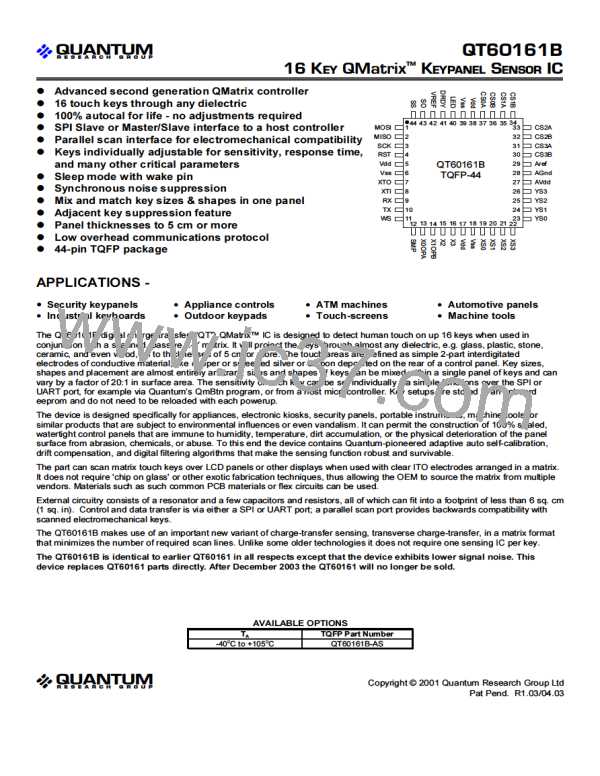©Quantum Research Group Ltd.
5.2 Scope Commands
5.3 Status Commands
Status commands cause the sensor to report back
information related to keys and their signals.
The host should always set the scope parameter when
initializing the part during normal operation as well as during
setup. Scope commands are persistent and apply to all
subsequent functions that are affected by scope, until a
different scope command is issued. On powerup or after reset
the device defaults to scope = 'all keys'.
It is not necessary to set the part to Get mode with these
commands, although it is advised to leave the part in Get
mode as a normal precaution (see Section 5.1)
Many functions only address one key regardless of the
current scope; in these cases the key being addressed is
always the key last set by the ‘s’ or ‘x’ and ‘y’ commands. If
the ‘s’ command was last set to key 9, then even though the
‘S’ command was issued afterwards the one-key scope will
remain key ‘9’. Similarly if ‘x’ was set to 2 and ‘y’ to 3, then
the one-key scope will remain key x=2 / y=3 (key #14). This
rule operates for either Put or Get commands.
0
0
X
30 - SIGNAL FOR
S
Bytes / Cmd # Bytes Rtnd
INGLE
K
EY
Scope
n/a
Returns
n/a
0..0xFFFF
Put
Get
n/a
1
n/a
2
1
Numeric '0'. Returns the signal level in 16-bit unsigned binary
for one key whose location is determined by scope. The least
significant byte is returned first.
Key numbering convention: The numbering of keys goes by
row then column. For example, the key in row X=3, column
Y=1 (X3Y1) is key 7. The formula for conversion of an X-Y
location to a key number is:
Note that the signal direction is inverted: decreasing values
correspond to more touch due to the physics of key detection
described in Section 1.1.
key number = X_row + (Y_column x 4)
1
0
X
31 - DELTA
S
IGNAL FOR
S
Bytes / Cmd # Bytes Rtnd
INGLE
K
EY
Scope
n/a
Returns
n/a
0x00..0xFF
Row and column numbers are per Fig. 1-5. Keys are acquired
in this same burst sequence, i.e. X0Y0, X1Y0, X2Y0 etc.
Put
Get
n/a
1
n/a
1
1
s
0
X
73 - SPECIFIC
K
Bytes / Cmd 2nd Byte Range
EY
S
COPE
Numeric '1'. Returns the value {Reference - Signal} in
unsigned 8-bit binary for one key whose location is
determined by scope. If Signal > Reference, the result is
truncated to zero. The return value is also limited to 255
(0xFF).
Scope
n/a
n/a
Returns
0x73
n/a
Put
Get
2
n/a
0x00..0x0F
n/a
Lowercase 'S'. Targets a specific individual key for all further
functions that are affected by scope. The second byte must
contain a binary key number from 0..15.
Increasing amounts of this value correspond to increasing
amounts of touch as the sign of signal is inverted (see 0x30
above).
S
0
X
53 - ALL
Scope
n/a
K
EYS
S
Bytes / Cmd 2nd Byte Range
COPE
Returns
0x53
n/a
2
0
X
32 - REFERENCE
V
Bytes / Cmd # Bytes Rtnd
ALUE
Put
Get
1
n/a
n/a
n/a
Scope
n/a
Returns
n/a
0..0xFFFF
n/a
Put
Get
n/a
1
n/a
2
1
Uppercase 'S'. Addresses all keys in the matrix for all further
functions that can target a group of keys.
Numeric '2'. Returns the Reference value in unsigned 16-bit
binary for one key whose location is determined by scope.
The least significant byte is returned first.
x
0
X
78 - ROW
Scope
n/a
K
EYS
S
Bytes / Cmd 2nd Byte Range
COPE
Returns
0x78
n/a
Put
Get
2
n/a
0x00..0x03
n/a
5
0
X
35 - DETECTION
I
Bytes / Cmd # Bytes Rtnd
NTEGRATOR
C
OUNTS
n/a
Scope
n/a
Returns
n/a
0x00..0xFF
Put
Get
n/a
1
n/a
1
Lowercase 'X'. Targets keys in a specific row for functions
that can address key groups. The second byte must contain a
row number from 0..3.
1
Numeric '5'. Returns the Detection Integrator counter value
for one key whose location is determined by scope. This
function is useful primarily for circuit diagnostics.
y
0
X
79 - COLUMN
K
Bytes / Cmd 2nd Byte Range
EYS
S
COPE
Scope
n/a
n/a
Returns
0x79
n/a
Put
Get
2
n/a
0x00..0x03
n/a
6
0
X
36 - EEPROM
CHECKSUM
Bytes / Cmd # Bytes Rtnd
Scope
n/a
n/a
Returns
n/a
0x00..0xFF
Put
Get
n/a
1
n/a
1
Lowercase 'Y'. Targets keys in a specific column for functions
that can address key groups. The second byte is a binary
column number from 0..3.
Numeric '6'. Returns the entire eeprom checksum. This
function is useful primarily for diagnostics and should
periodically be used to check for valid eeprom contents.
The checksum should be computed when the entire device's
settings, including the locked reference levels ('L' command)
are known. The host can then periodically test the checksum
to validate eeprom integrity. If needed, the eeprom can then
lQ
18
www.qprox.com QT60161B / R1.03

 QUANTUM [ QUANTUM RESEARCH GROUP ]
QUANTUM [ QUANTUM RESEARCH GROUP ]